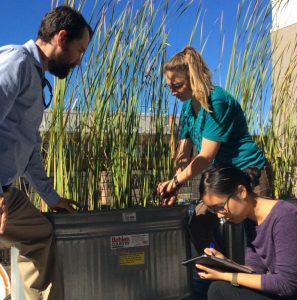Study Describes How Marine Particle Aggregates Influence Oil Spill Fate
– NOVEMBER 2, 2017
Researchers analyzed simulated interactions of oil droplets and marine particle aggregates to understand how they could affect the behavior of an oil spill. The scientists found that the attachment of oil droplets to particle aggregates changed the distribution of oil droplet sizes over time scales of hours. As oil droplet sizes got larger, a greater fraction of the total oil volume attached to marine aggregates and sank. As oil droplet size got smaller, which they would if chemical dispersants are used, the total volume of oil that sank with marine aggregates reduced by 10 – 90%. This change might influence oil spill evolution if there were a large enough concentration of oil and marine aggregates. The researchers published their findings in Journal of Geophysical Research: Oceans: Collision of oil droplets with marine aggregates: Effect of droplet size.
Submerged oil droplets can collide with each other, aquatic organisms, or solid particle aggregates (i.e., marine snow) in the water column. When oil attaches to marine aggregates, the biogeochemistry of aggregates change as does the removal rate of oil (by sinking) from the water column. Understanding the resulting effects of oil removed from the water column is important to predicting and understanding the behavior and fate of an oil spill.
Researchers in this study combined three existing models used for quantifying the motion and particle-capture dynamics of marine aggregates. They evaluated the model using parameters spanning a wide range of values reflecting oil spill conditions and calculated the droplet-aggregate collision rate for three dominant collision mechanisms (diffusion, settling, and shear).
The researchers observed that multiple mechanisms were equally important (typically settling and shear) when oil droplets and marine aggregates each had a radius of 10 micrometers. However, as marine aggregates became larger, the dominant mechanism that drove oil-aggregate collision was the settling velocity of aggregates as they sank through the water column.
The team concluded that droplet-aggregate collision predictions in scenarios when multiple mechanisms are equally important require an equation that includes the combined effects of differential settling and turbulent shear. The researchers suggested that future work focus on deriving this equation. Variano is also taking his work in the direction of understanding sediment and oil dynamics in wetlands.
The study’s authors are Ruth A. Lambert and Evan A. Variano.
************
This research was made possible in part by a grant from the Gulf of Mexico Research Initiative (GoMRI) to the Gulf of Mexico Integrated Spill Response Consortium (GISR).
The Gulf of Mexico Research Initiative (GoMRI) is a 10-year independent research program established to study the effect, and the potential associated impact, of hydrocarbon releases on the environment and public health, as well as to develop improved spill mitigation, oil detection, characterization and remediation technologies. An independent and academic 20-member Research Board makes the funding and research direction decisions to ensure the intellectual quality, effectiveness and academic independence of the GoMRI research. All research data, findings and publications will be made publicly available. The program was established through a $500 million financial commitment from BP. For more information, visit https://gulfresearchinitiative.org/.
© Copyright 2010-2017 Gulf of Mexico Research Initiative (GoMRI) – All Rights Reserved. Redistribution is encouraged with acknowledgement to the Gulf of Mexico Research Initiative (GoMRI). Please credit images and/or videos as done in each article. Questions? Contact web-content editor Nilde “Maggie” Dannreuther, Northern Gulf Institute, Mississippi State University (maggied@ngi.msstate.edu).






